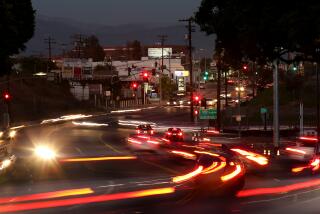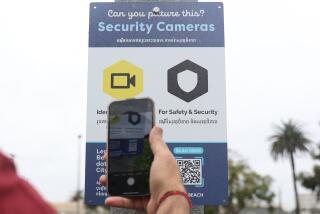Device to Nab Red-Light Runners Found Ineffective
It was to have been the latest addition to Pasadenaâs high-tech traffic-control arsenal, a computerized surveillance camera that 24 hours a day could snap pictures of cars zipping through red lights.
But after several months of testing at two busy intersections, enthusiasm for the device, called a Multafot, has stalled.
Police were dismayed to find that the red-light sensors--which along with the cityâs controversial photo radar system were firsts of their kind in California--were being triggered by legal driving maneuvers nearly 95% of the time.
âLot of False Photographsâ
âWe were getting an awful lot of false photographs,â said Lt. Robert Huff, adding that no citations were handed out during the tests. âI wouldnât say the problems are insurmountable . . . but thereâs a number of things that we have to take into account that we didnât know about.â
At the two intersections--California Boulevard and Hill Avenue, and Fair Oaks Avenue and Union Street--every three or four days the magnetic sensors placed in the pavement indicated that about 200 cars were running red lights. But after developing the film, an average of only 10 to 15 of the 200 cars photographed were actually filmed in illegal moves, Huff said.
The device, which takes two rapid-fire photos every time it is triggered, showed that most of the cars had either stopped with their noses sticking a bit too far into the intersection or, in making a left turn, were forced to pass through a red light after waiting for oncoming traffic to come to a halt.
âTechnically, those could be violations, but we would never issue a citation because theyâre not really endangering anyone,â said Huff, head of the Police Departmentâs traffic division. âThe idea was to get the actual red-light runners.â
However, the firm that sells the $45,000 Multafot, which has been used extensively in Switzerland and West Germany, said the problem in Pasadena was with the choice of intersections and the positioning of the sensors.
Had city officials been more willing to fine-tune the location of the sensors or to select streets with more regimented traffic flows, the Multafot would have detected violators more efficiently, said Robert P. Umbdenstock, president of Multanova/RPJ Inc., based in San Anselmo, the U.S. distributor of the devices.
More to Read
Sign up for Essential California
The most important California stories and recommendations in your inbox every morning.
You may occasionally receive promotional content from the Los Angeles Times.










